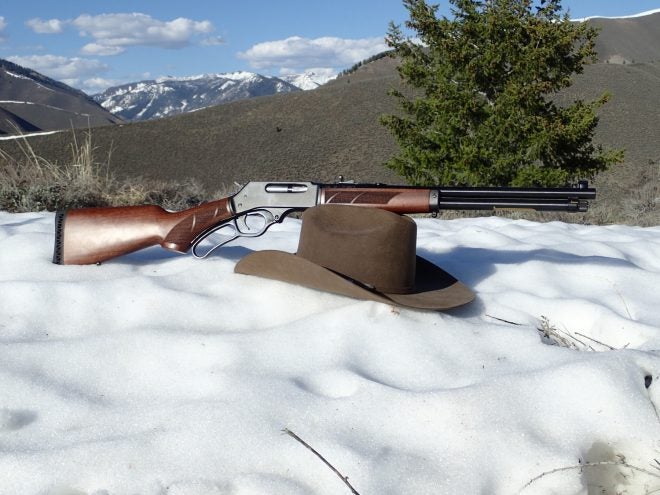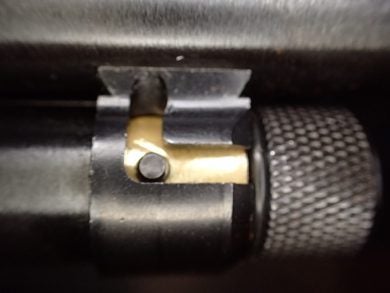I am an avid user of lever-actions. I routinely carry them while on long hikes, and have used them to good effect while hunting in short to mid range situations where I know quick shots and follow ups will be necessary. I have also used the .45-70 for a number of years for hunting and bear protection purposes in both lever action and falling block guns. The .45-70 is an interesting cartridge. Over 140 years old (its inception was in 1873 as a replacement for .50-70), it is still used widely in many commercial rifles, and ammunition is not difficult to source in the USA. The cartridge is also still issued and used militarily in blank form for line launchers used by the navy and coast guard! While it has quite a lot of drop and is susceptible to wind deviation due to low velocities, I have used it to devastating effect on thick skinned, heavy-boned game, and it still can deliver one-shot kills to all North American big game within 200 yards. I was therefore enthused when I heard I would be receiving a Henry H010 “Steel” rifle Chambered in .45-70 for testing.
Initial Impressions:
Despite having sold, appraised, and repaired numerous Henry rifles, this was the first one of their rifles I have had the opportunity to use myself. The rifle comes in Henry’s cardboard box with a manual and not much else. Upon opening the box, I inspected the gun and found no blemishes or burrs. The action was properly oiled and clean from the get-go. I was a little surprised to see that it had buckhorn sights, as previous iterations of this particular model, H010, had a ghost ring rear aperture sight. The receiver is drilled and tapped for other sights or a scope mount base. The bolt to receiver fit was very tight with no wobble. The combination of an open ejection port and a Henry removable tube-style magazine certainly make for a very distinct look. The pistol grip walnut stock was very nicely finished and checkered. I prefer a pistol grip style stock on my lever actions for a more comfortable grip angle, so this was nice to see. The buttstock also has a nice squishy rubber buttpad which negated the brunt of heavier loads fired later on, as well as kept the gun squarely in place when shouldered. All said, a fine example of American craftmanship. (For those of you unfamiliar with the company, Henry’s motto is: “Made in America, or not at all!”)
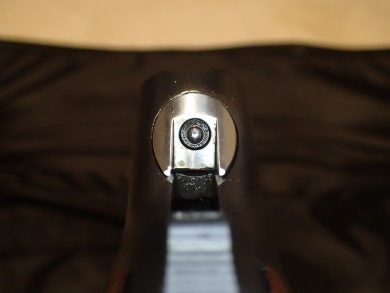
excellent bolt to receiver fit
Field and Range Impressions:
Before heading out into the field, I weighed the rifle and tested the trigger weight. Coming in at 7lbs,4oz/3.29kg, the Henry is the lightest weight .45-70 repeater currently in production. Some of the weight savings can be found in the 18.34″ barrel length, but the Henry’s receiver is narrower and simpler, having no loading gate. The trigger consistently broke at 5lbs. It is not the best trigger I have had on a lever gun, being outclassed by Wild West Guns’ “Trigger Happy Kit”, but it was much better than a factory Winchester or Marlin trigger. No creep, just a nice clean break at 5lbs with minimal wobble that lever gun triggers sometimes have. The moderate weight was nice when taking the rifle on a pretty lengthy hike through late spring snow in the mountains.
Moving on to the range, I had some likes and dislikes about its operation. The rifle is loaded by first closing the bolt, then twisting the knurled cap of the brass inner magazine tube a quarter turn, and either removing it to the point it exposes the loading port in the outer magazine tube, or removing it completely. Thereafter, one just has to drop the cartridges in, and slide the inner magazine tube back in, turning it again to secure it in place. Then one can work the action and fire, or render the rifle safe by pointing the rifle in a safe direction and then placing one’s thumb on the hammer and pressing the trigger, easing the hammer into place on the bolt. Unloading is the simplest of all lever actions, simply open the action, ejecting whatever round is chambered, and then remove the inner magazine tube. Any rounds left in the outer magazine tube can then simply slide out by pointing the muzzle to the ground, rechecking the chamber afterwards.
While I liked the ease of loading and unloading the rounds using the magazine tube, rather than pressing each round through a loading gate, I disliked having to have the muzzle pointed upwards or the rifle inverted to load rounds into the tube. On another point, one can potentially muzzle oneself while removing the inner magazine tube. At first, it took me while to to get used to the concept that I was loading a cartridge firearm with the barrel pointed upwards with my hand downrange of the muzzle while the bolt was closed. It is almost conceptually like loading a muzzleloader. One should always be mindful to check that the rifle is totally clear in this respect, and do one’s best to keep hands clear of the muzzle when removing and replacing the inner magazine tube. Also, certain ranges may have rules about muzzle direction, even during reloading, so a chat with the range officer might be a good idea if one is using this rifle at such a range. I also disliked having my support hand so far out of my “work space” and having to disassemble the magazine tube during the loading procedure. I do understand that emergency reloads can be achieved by loading directly into the firing port, but I’d rather use a loading gate or box magazine with a lever action. I also disliked not having a cross bolt safety, and having to ease the hammer forward to put the rifle “on safe”. I understand that safeties are mechanical devices that can and will fail, but given that arrangement, I’d certainly choose to keep the chamber cold until ready to engage in the field.
- 1. Rotate end of inner magazine tube
- 2. Inner magazine tube ready to slide forward
- 3. Loading port is exposed
- 4. Load rounds into port
- 5. Replace inner magazine tube
- Brass inner magazine tube removed and below outer magazine tube
Range Results:
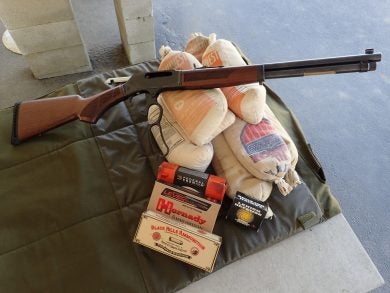
Ready to make some noise at the range
Accuracy testing was conducted using buckhorn sights at 50 yards off a sandbag rest with 5 shot groups measured center to center. I used 50 yards rather than my usual 100 due to the brass beaded front sight covering a 8×8″ square target completely at 100 yards. At 50 yards, it covered a 4×4″ square. Results are as follows, listed from best to worst groups:
- Hornady Leverevolution 325gr FTX: 1.153″
- Federal 300gr TBBC: 1.3″
- Lehigh Defense 305gr Xtreme Penetrator: 1.6″
- Hornady Leverevolution 250gr Monoflex: 1.61″
- Lehigh Defense Controlled Fracturing: 2.2″
- Black Hills Cowboy 405gr FPL: 3.2″
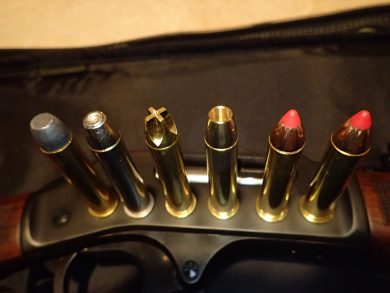
Ammunition tested L to R: BH FPL, Federal TBBC, Lehigh Xtreme Penetrator, Lehigh Controlled Fracturing, Hornady 250 Monoflex, Hornady 325 FTX
I was very pleased with all the groups, being that they were all smaller than the are which the sight covered. I am sure that groups would be tighter if I was using Henry’s optional ghost ring sight or an optic. The faster cartridges tended to have less dispersion. The 1:20 twist barrel preferred the Hornady 325gr FTX Leverevolution round, which has a straighter trajectory than flat pointed rounds and has performed excellently on game in my experience. Recoil ranged from mild and pleasantly smokey with the Black Hills Cowboy loads to stout with a muzzle flash that was visible in broad daylight with the Lehigh loads. I then ran some speed drills with the rifle using the Black Hills 405gr loads, as they had the least recoil. I was able to get off 5 aimed shots in 7 seconds from the low ready position, and placed them all into a 4″ square at 25 yards. Being that a charging grizzly can cover 50 yards in 3 seconds, a short stroke kit might be a good investment if one is carrying such a rifle in thickly vegetated grizzly country. At the range, I also noticed that the brass front sight was much harder to see in the shade than in the sun. All said, buckhorn sights are not my favorite on a levergun, and I prefer a ghost ring arrangement on my personal leverguns. The lever was smooth and the action ejected all rounds positively as long as I didn’t accidentally short-stroke. The lever itself did not pinch or otherwise rap my hands on operation or recoil. The Henry was utterly reliable, and I did not have one malfunction in over 200 rounds fired.
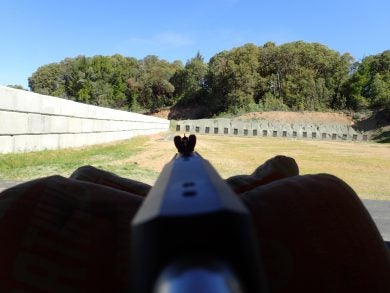
The brass front sight became much harder to pick up when in the shade
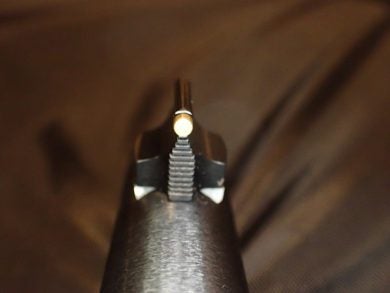
Front sight lit up and was easy to see when I stepped out into the sun
Conclusions:
The Henry H010 is a fine example of a reasonably priced, American made big-bore rifle. It’s short barrel length makes it handy in closed in brush and dense woods, which is a real asset in dangerous game situations. The craftsmanship in this rifle is rather remarkable for its price point as well, and I found it to be extremely well-made. The .45-70 cartridge in which it is chambered is readily available and relatively inexpensive compared to other big-game cartridges. If you are thinking about getting into big-bore leverguns, I would compare a few other options to decide if one prefers the Henry’s idiosyncrasies of operation, but for a short-to-medium range rifle in a hard-hitting caliber, it is well worth a look and nearly untouchable in its category at its price point.
Pros:
- Well made with exceptional value at $850 MSRP
- Handy, lightweight, and well balanced
- Easy loading and unloading
- Powerful, accurate and reliable
- Easy to operate either right or left handed
Cons:
- Loading procedure can cause one to muzzle oneself (cardinal rule #2)
- Lack of manual safety
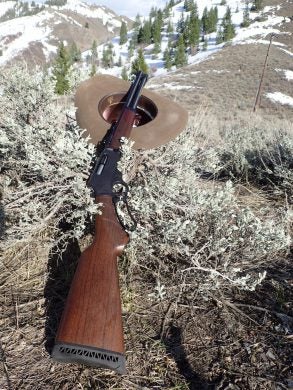
Thanks to Aaron Hughston Shooting School for logistical support, range time, and technical assistance
For more information, please visit Henry’s site.
 Your Privacy Choices
Your Privacy Choices
